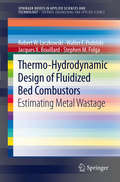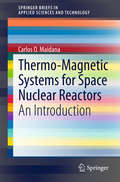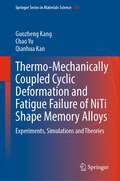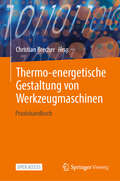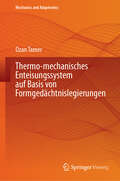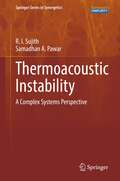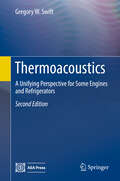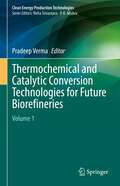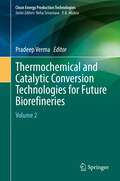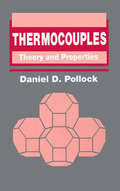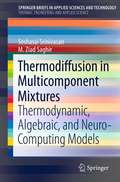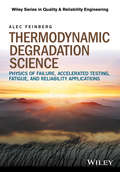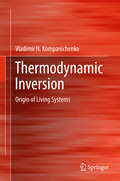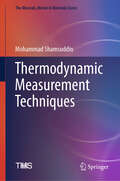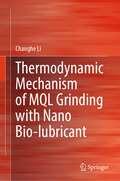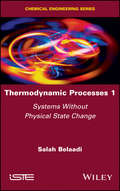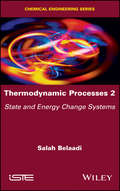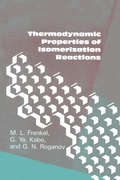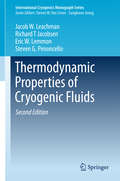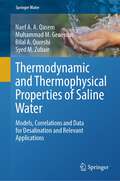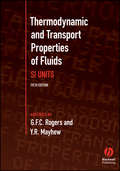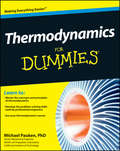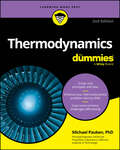- Table View
- List View
Thermo-Hydrodynamic Design of Fluidized Bed Combustors
by Stephen M. Folga Walter F. Podolski Jacques X. Bouillard Robert W. LyczkowskiThermo-Hydrodynamic Design of Fluidized Bed Combustors: Estimating Metal Wastage is a unique volume that finds that the most sensitive parameters affecting metal wastage are superficial fluidizing velocity, particle diameter, and particle sphericity. Gross consistencies between disparate data sources using different techniques were found when the erosion rates are compared on the same basis using the concept of renormalization. The simplified mechanistic models and correlations, when validated, can be used to renormalize any experimental data so they can be compared on a consistent basis using a master equation.
Thermo-Magnetic Systems for Space Nuclear Reactors
by Carlos O. MaidanaIntroduces the reader to engineering magnetohydrodynamics applications and presents a comprehensive guide of how to approach different problems found in this multidisciplinary field. An introduction to engineering magnetohydrodynamics, this brief focuses heavily on the design of thermo-magnetic systems for liquid metals, with emphasis on the design of electromagnetic annular linear induction pumps for space nuclear reactors. Alloy systems that are liquid at room temperature have a high degree of thermal conductivity far superior to ordinary non-metallic liquids. This results in their use for specific heat conducting and dissipation applications. For example, liquid metal-cooled reactors are typically very compact and can be used in space propulsion systems and in fission reactors for planetary exploration. Computer aided engineering (CAE), computational physics and mathematical methods are introduced, as well as manufacturing and testing procedures. An overview on space nuclear systems is also included. This brief is an invaluable tool for design engineers and applied physicists as well as to graduate students in nuclear and mechanical engineering or in applied physics.
Thermo-Mechanically Coupled Cyclic Deformation and Fatigue Failure of NiTi Shape Memory Alloys: Experiments, Simulations and Theories (Springer Series in Materials Science #335)
by Guozheng Kang Qianhua Kan Chao YuWritten by leading experts in the field, this book highlights an authoritative and comprehensive introduction to thermo-mechanically coupled cyclic deformation and fatigue failure of shape memory alloys. The book deals with: (1) experimental observations on the cyclic deformation and fatigue failure in the macroscopic and microscopic scales; (2) molecular dynamics and phase-field simulations for the thermo-mechanical behaviors and underlying mechanisms during cyclic deformation; (3) macroscopic phenomenological and crystal plasticity-based cyclic constitutive models; and (4) fatigue failure models. This book is an important reference for students, practicing engineers and researchers who study shape memory alloys in the areas of mechanical, civil and aerospace engineering as well as materials science.
Thermo-Poroelasticity and Geomechanics
by Selvadurai A. P. S. Suvorov A. P.Investigations of multi-physical processes in geomaterials have gained increasing attention due to the ongoing interest in solving complex geoenvironmental problems. This book provides a comprehensive exposition of the classical theory of thermo-poroelasticity, complemented by complete examples to problems in thermo-poromechanics that are used to validate computational results from multi-physics codes used in practice. The methodologies offer an insight into real-life problems related to modern environmental geosciences, including nuclear waste management, geologic sequestration of greenhouse gases to mitigate climate change, and the impact of energy resources recovery on groundwater resources. A strong focus is placed on analytical approaches to benchmark the accuracy of the computational approaches that are ultimately used in real-life problems. The extensive coverage of both theory and applications in thermo-poroelasticity and geomechanics provides a unified presentation of the topics, making this an accessible and invaluable resource for researchers, students or practitioners in the field.
Thermo-energetische Gestaltung von Werkzeugmaschinen: Praxishandbuch
by Christian BrecherThermo-energetische Gestaltung von Werkzeugmaschinen Dieses Buch beschreibt Maßnahmen zur Sicherstellung der Bearbeitungsgenauigkeit unter thermisch instationären Bedingungen bei gesteigerter Produktivität, ohne zusätzliche Energie für die Temperierung aufzuwenden. Es werden Forschungsergebnisse zu thermischen Einflüssen sowie deren Beeinflussung und Beherrschung vorgestellt. Die dargestellten Entwicklungsarbeiten wurden im Rahmen des Sonderforschungsbereich/Transregio 96 (SFB/TR 96) von der DFG gefördert und umfassen die Weiterentwicklung von Modellgrundlagen, Kompensationsmaßnahmen und steuerungsintegrierte Korrekturverfahren. Im Bereich der Modellgrundlagen werden die Modellierung von Baugruppen und Gesamtmaschinen, die Verhaltensanalyse, die Parametrierung und effizienzsteigernde Berechnungsmethoden behandelt. Die Kompensationsmaßnahmen umfassen Fluidkreisläufe und die aktive Steuerung von Wärmeflüssen. Die steuerungsintegrierten Korrekturverfahren beinhalten sowohl modellbasierte als auch messtechnisch basierte Ansätze. Zusätzlich werden die entwickelten Lösungsverfahren und Ergebnisse aus der praktischen Erprobung an Baugruppen und Gesamtmaschinen bewertet. Das Open-Access-Buch richtet sich an Praktiker aus dem Bereich des Werkzeugmaschinenbaus.
Thermo-mechanisches Enteisungssystem auf Basis von Formgedächtnislegierungen (Mechanics and Adaptronics)
by Ozan TamerIn dieser Forschungsarbeit wird ein neuartiges Enteisungssystemkonzept untersucht, bei dem ein Draht aus einer Formgedächtnislegierung (FGL) in ein Elastomermaterial eingebettet wird, um thermomechanische Effekte zu erzielen. Die besonderen thermischen und mechanischen Eigenschaften von FGL machen sie zu einer vielversprechenden Option für die Integration in Luftfahrtsysteme, um Eisansammlungen auf aerodynamischen Oberflächen zu entfernen. Das Konzept basiert auf der Nutzung des Formgedächtniseffekts (FGL) als Grundprinzip für das Enteisungssegment.
Thermoacoustic Instability: A Complex Systems Perspective (Springer Series in Synergetics)
by R. I. Sujith Samadhan A. PawarThis book systematically presents the consolidated findings of the phenomenon of self-organization observed during the onset of thermoacoustic instability using approaches from dynamical systems and complex systems theory. Over the last decade, several complex dynamical states beyond limit cycle oscillations such as quasiperiodicity, frequency-locking, period-n, chaos, strange non-chaos, and intermittency have been discovered in thermoacoustic systems operated in laminar and turbulent flow regimes. During the onset of thermoacoustic instability in turbulent systems, an ordered acoustic field and large coherent vortices emerge from the background of turbulent combustion. This emergence of order from disorder in both temporal and spatiotemporal dynamics is explored in the contexts of synchronization, pattern formation, collective interaction, multifractality, and complex networks. For the past six decades, the spontaneous emergence of large amplitude, self-sustained, tonal oscillations in confined combustion systems, characterized as thermoacoustic instability, has remained one of the most challenging areas of research. The presence of such instabilities continues to hinder the development and deployment of high-performance combustion systems used in power generation and propulsion applications. Even with the advent of sophisticated measurement techniques to aid experimental investigations and vast improvements in computational power necessary to capture flow physics in high fidelity simulations, conventional reductionist approaches have not succeeded in explaining the plethora of dynamical behaviors and the associated complexities that arise in practical combustion systems. As a result, models and theories based on such approaches are limited in their application to mitigate or evade thermoacoustic instabilities, which continue to be among the biggest concerns for engine manufacturers today. This book helps to overcome these limitations by providing appropriate methodologies to deal with nonlinear thermoacoustic oscillations, and by developing control strategies that can mitigate and forewarn thermoacoustic instabilities. The book is also beneficial to scientists and engineers studying the occurrence of several other instabilities, such as flow-induced vibrations, compressor surge, aeroacoustics and aeroelastic instabilities in diverse fluid-mechanical environments, to graduate students who intend to apply dynamical systems and complex systems approach to their areas of research, and to physicists who look for experimental applications of their theoretical findings on nonlinear and complex systems.
Thermoacoustics: A Unifying Perspective for Some Engines and Refrigerators
by Gregory W. SwiftThis updated new edition provides an introduction to the field of thermoacoustics. All of the key aspects of the topic are introduced, with the goal of helping the reader to acquire both an intuitive understanding and the ability to design hardware, build it, and assess its performance. Weaving together intuition, mathematics, and experimental results, this text equips readers with the tools to bridge the fields of thermodynamics and acoustics. At the same time, it remains firmly grounded in experimental results, basing its discussions on the distillation of a body of experiments spanning several decades and countries. The book begins with detailed treatment of the fundamental physical laws that underlie thermoacoustics. It then goes on to discuss key concepts, including simple oscillations, waves, power, and efficiency. The remaining portions of the book delve into more advanced topics and address practical concerns in applications chapters on hardware and measurements. With its careful progression and end-of-chapter exercises, this book will appeal to graduate students in physics and engineering as well as researchers and practitioners in either acoustics or thermodynamics looking to explore the possibilities of thermoacoustics. This revised and expanded second edition has been updated with an eye to modern technology, including computer animations and DeltaEC examples.
Thermochemical and Catalytic Conversion Technologies for Future Biorefineries: Volume 1 (Clean Energy Production Technologies)
by Pradeep VermaThis book will attempt to provide an account of knowledge on biomass available for biomass-based biorefineries. Its focuses on understanding the recalcitrance of biomass and how it limits the overall conversion efficiency. It also gives an insight what are different conventional approaches available for pretreatment and hydrolysis of the biomass. The chapters deals with highlights how enzymes can be a powerhouse and play pioneering roles in biomass valorization. The book will also throw light on how technical aspects of thermochemical conversion strategies such as pyrolysis, gasification, organosolv methods for the generation of value-added materials such as high-quality bio-oil, biochars, and biobased chemicals. These high-value compounds can be put to widespread application in biofuel, biocatalyst, waste bioremediation (heavy metal removal), air purification and effluent treatment applications. The book will provide literature on the limitations of already existing technologies and provide prospects of each technology. This book is of interest to teachers, researchers, bioenergy scientists, capacity builders, and policymakers. Also, the book serves as additional reading material for undergraduate and graduate students of energy studies, chemical engineering, biotechnology, and environmental sciences. National and international energy scientists and policymakers will also find this to be a useful read.
Thermochemical and Catalytic Conversion Technologies for Future Biorefineries: Volume 2 (Clean Energy Production Technologies)
by Pradeep VermaThis book is an attempt to provide an account of biomass recalcitrance and available physical and chemical methods for biomass pretreatment and hydrolysis. Its focuses on understanding the critical role of enzymes in the development of integrated biorefinery. The book also presents an overview of the utilization of waste biomass as a support system for enzyme immobilization for easy recovery and reuse for multiple cycles. strategies where enzymes can be used. The book also attempts to understand how enzymes can play a vital role in waste valorization for energy and biomaterial production. Further, the book will present an overview of how advanced technologies such as omics and in-silico approaches can help in understanding the chemistry affecting recalcitrance and the mechanism of enzyme catalysts in their bioconversion. An understanding of the life cycle assessment of waste biomass biorefinery will be needed before its implementation. The book will serve as additional reading material for undergraduate and graduate students of energy studies, chemical engineering, applied biotechnology, and environmental sciences. This book is of interest to academicians, scientists, environmentalists, and policymakers.
Thermocouples: Theory and Properties
by DanielD. PollockThermocouples: Theory and Properties provides the basis for the examination and explanation of thermoelectric phenomena and their correlations with other physical properties. These results are applied and account for the properties and deviations of commercial materials in the temperature ranges of most common industrial usage.This book is written expressly for non-scientists and is an effective tool for the busy technician or engineer working with thermoelectric thermometry in metallurgical, chemical, petroleum, pharmaceutical, and food processing areas. It is also beneficial for use in quality control and research and development applications. The book provides more than the usual superficial presentations of thermoelectric properties; it explains the ""why"" as well as the ""how"" and ""what"" of thermoelectric behaviors. These answers are important because only a suitable combination of theory and practice can lead to the understanding required for optimum thermometric applications under the multitude of applications encountered in industry and science.
Thermodiffusion in Multicomponent Mixtures
by M. Ziad Saghir Seshasai SrinivasanThermodiffusion in Multicomponent Mixtures presents the computational approaches that are employed in the study of thermodiffusion in various types of mixtures, namely, hydrocarbons, polymers, water-alcohol, molten metals, and so forth. We present a detailed formalism of these methods that are based on non-equilibrium thermodynamics or algebraic correlations or principles of the artificial neural network. The book will serve as single complete reference to understand the theoretical derivations of thermodiffusion models and its application to different types of multi-component mixtures. An exhaustive discussion of these is used to give a complete perspective of the principles and the key factors that govern the thermodiffusion process.
Thermodynamic Degradation Science: Physics of Failure, Accelerated Testing, Fatigue, and Reliability Applications
by Alec FeinbergThermodynamic degradation science is a new and exciting discipline. This book merges the science of physics of failure with thermodynamics and shows how degradation modeling is improved and enhanced when using thermodynamic principles. The author also goes beyond the traditional physics of failure methods and highlights the importance of having new tools such as "Mesoscopic" noise degradation measurements for prognostics of complex systems, and a conjugate work approach to solving physics of failure problems with accelerated testing applications. Key features: * Demonstrates how the thermodynamics energy approach uncovers key degradation models and their application to accelerated testing. * Demonstrates how thermodynamic degradation models accounts for cumulative stress environments, effect statistical reliability distributions, and are key for reliability test planning. * Provides coverage of the four types of Physics of Failure processes describing aging: Thermal Activation Processes, Forced Aging, Diffusion, and complex combinations of these. * Coverage of numerous key topics including: aging laws; Cumulative Accelerated Stress Test (CAST) Plans; cumulative entropy fatigue damage; reliability statistics and environmental degradation and pollution. Thermodynamic Degradation Science: Physics of Failure, Accelerated Testing, Fatigue and Reliability Applications is essential reading for reliability, cumulative fatigue, and physics of failure engineers as well as students on courses which include thermodynamic engineering and/or physics of failure coverage.
Thermodynamic Inversion
by Vladimir N. KompanichenkoThis book discusses the theory, general principles, and energy source conditions allowing for the emergence of life in planetary systems. The author examines the material conditions found in natural hydrothermal sites, the appropriate analogs of prebiotic environments on early Earth. He provides an overview of current laboratory experiments in prebiotic materials chemistry and substantiation of a new direction for the experiments in the origin of life field.Describes thermodynamic inversion and how it relates to the living cell;Examines the current direction of experiments on prebiotic materials chemistry;Introduces and substantiates necessary conditions for the emergence of life.
Thermodynamic Measurement Techniques (The Minerals, Metals & Materials Series)
by Mohammad ShamsuddinThis book offers various techniques for measurement of thermodynamic quantities of materials such as enthalpy, free energy, and entropy. Techniques described herein include calorimetry, chemical equilibria, vapour pressure, and electrochemical analysis. The book covers general and solution thermodynamics in Chapters 1 and 2, respectively, and highlights the significance of various thermodynamic quantities required for materials characterization and development in Chapter 3. The author goes on to discuss different thermodynamic measurement techniques in detail (Chapters 4-8) together with a set of more than fifty worked-out problems related to classical as well as solution thermodynamics and measurement techniques. (Chapter 9).Topics include but are not limited to the following:The significance of various thermodynamic data required for selection and characterization of materials.The physicochemical principles involved in various thermodynamic measurement and on the evaluation of thermodynamic data by phase diagram analyses. The unique combination of calorimetry and chemical equilibrium for simultaneous determination of partial molar enthalpy and partial molar free energy of hydrogen in metals and alloys.The special technique based on the combination of vapor pressure and electrical conductivity to study the effect of tellurium vapor pressure on the mode of conduction in polycrystalline cadmium telluride.
Thermodynamic Mechanism of MQL Grinding with Nano Bio-lubricant
by Changhe LiThis book discusses the thermodynamic mechanism of MQL grinding with nano-biological lubricant from the force, heat, surface integrity, and micro-morphology.It makes up the fatal defect of the lack of heat transfer capability of traditional MQL grinding. The machining accuracy, surface quality, especially surface integrity of the workpiece, are significantly improved; at the same time, the service life of the grinding wheel is increased and the working environment is improved.The general scope of the book’s content is the effects of MQL grinding with nano-bio-lubricant on grinding force, thermal mechanism, and surface.It provides a new method of sustainable green grinding for environment-friendly, resource-saving, and energy-efficient utilization and solves the technical bottleneck of the insufficient capacity in MQL heat transfer.
Thermodynamic Processes 1: Systems without Physical State Change
by Salah BelaadiThermodynamic Processes 1 offers a comprehensive take on process engineering, whereby technology transforms materials and energy production into various products. The scientific methods required for designing such processes are the result of knowledge from a number of different disciplines. As a result, thermodynamics is the basic discipline in process engineering training. The application of laws and concepts of thermodynamics is essential before the design and optimization of any process, which allows downstream to control its reliability and validity. This book offers a pragmatic approach through practical and varied examples, chosen for their didactic and industrial interest.
Thermodynamic Processes 2: State and Energy Change Systems
by Salah BelaadiThermodynamic Processes 2 is devoted to the study of equilibrium between phases in the case of the four changes of physical state: fusion, boiling or vaporization, sublimation and allotropy or transition. It also includes a section that addresses energy's relationship to the zero sum aspect of exergy and thermal cycles. This second volume presents scientific and technical examples – both theoretical and industrial – which are the result of a careful selection, accrued over more than three decades of teaching thermodynamics and in collaboration with the industry sector. The didactic exercises and the practical problems are entirely dedicated to the understanding of this science, and the potential applications for the industrial world. This book is a tool for work and reflection essential for the student in training, as well as the engineer or experienced researcher.
Thermodynamic Properties Of Isomerization Reactions
by M. L. FrenkelThis handbook presents the thermodynamic functions obtained primarily from the results of equilibrium studies of isomerization reactions and by measurements of the heats of combustion of isomer groups by the calorimetric method.
Thermodynamic Properties of Cryogenic Fluids
by Jacob W. Leachman Richard T Jacobsen Eric W. Lemmon Steven G. PenoncelloPracticing engineers and scientist will benefit from this book's presentation of the most accurate information on the subject. The equations for fifteen important cryogenic fluids are presented in a basic format, accompanied by pressure-enthalpy and temperature-entropy charts and tables of thermodynamic properties. The book is supported by ICMPROPRS - an interactive computer program for the calculation of thermodynamic properties of the cryogenic fluids - that can be downloaded from the World Wide Web.
Thermodynamic and Thermophysical Properties of Saline Water: Models, Correlations and Data for Desalination and Relevant Applications (Springer Water)
by Naef A. Qasem Muhammad M. Generous Bilal A. Qureshi Syed M. ZubairThis book accommodates the existing correlations, data, and methods for thermodynamic and thermophysical properties of saline water, including multiple components at a wide range of salinity (reaching around 200 g/kg), temperature, and pressure. The correlations of each property are plotted against existing experimental data to judge the comparative accuracy of each within a given specific range of salinity, temperature, and pressure. An assessment to recommend some correlations is also conducted. New correlations for some properties are also proposed. This book helps to provide the saline water properties as needed for engineers, designers, and research for different areas, including desalination and water treatment.All the analytical analysis, thermodynamic analysis, and design models of the desalination technologies depend on saline water properties. As scientists and researchers working on different desalination technologies, the authors found it difficult to find all saline water properties in one source, including multicomponent and binary salty solutions, under different conditions (salinity, temperature, and pressure). Therefore, the authors introduce this book to fill the gap in the open literature. This book compiles the thermodynamic and thermophysical properties of saline water, involving thermodynamic approaches, multicomponent models, and simple correlations and data, comparison between the correlations of properties in figures, recommendation of the most accurate correlations and methods, and the used codes to estimate these correlations and methods. It is expected that this book to be a principal source for all interests in desalination and water treatment subjects.
Thermodynamic and Transport Properties of Fluids
by G. F. Rogers Y. R. MayhewThe fifth edition has been issued to incorporate two new tables - Data of Refrigerant 134a and a table containing for selected substances, molar enthalpies and molar Gibbs functions of formation, Equilibirum constants of formation, as well as molar heat capacities and absolute entropies.
Thermodynamics
by Gregory Nellis Sanford KleinThis book differs from other thermodynamics texts in its objective which is to provide engineers with the concepts, tools, and experience needed to solve practical real-world energy problems. The presentation integrates computer tools (e.g., EES) with thermodynamic concepts to allow engineering students and practising engineers to solve problems they would otherwise not be able to solve. The use of examples, solved and explained in detail, and supported with property diagrams that are drawn to scale, is ubiquitous in this textbook. The examples are not trivial, drill problems, but rather complex and timely real world problems that are of interest by themselves. As with the presentation, the solutions to these examples are complete and do not skip steps. Similarly the book includes numerous end of chapter problems, both typeset and online. Most of these problems are more detailed than those found in other thermodynamics textbooks. The supplements include complete solutions to all exercises, software downloads, and additional content on selected topics. These are available at the book web site www.cambridge.org/KleinandNellis.
Thermodynamics For Dummies
by Michael PaukenTake some heat off the complexity of thermodynamics Does the mere thought of thermodynamics make you sweat? It doesn't have to! This hands-on guide helps you score your highest in a thermodynamics course by offering easily understood, plain-English explanations of how energy is used in things like automobiles, airplanes, air conditioners, and electric power plants. Thermodynamics 101 - take a look at some examples of both natural and man-made thermodynamic systems and get a handle on how energy can be used to perform work Turn up the heat - discover how to use the first and second laws of thermodynamics to determine (and improve upon) the efficiency of machines Oh, behave - get the 411 on how gases behave and relate to one another in different situations, from ideal-gas laws to real gases Burn with desire - find out everything you need to know about conserving mass and energy in combustion processes Open the book and find: The laws of thermodynamics Important properties and their relationships The lowdown on solids, liquids, and gases How work and heat go handin hand The cycles that power thermodynamic processes Chemical mixtures and reactions Ten pioneers in thermodynamics Real-world applications of thermodynamic laws and concepts Learn to: Master the concepts and principles of thermodynamics Develop the problem-solving skills used by professional engineers Ace your thermodynamics course
Thermodynamics For Dummies
by Michael PaukenThe thermodynamics knowledge you need to succeed in class—and in your career Thermodynamics For Dummies, 2nd Edition covers the topics found in a typical undergraduate introductory thermodynamic course (which is an essential course to nearly all engineering degree programs). It also brings the subject to life with exciting content on where (and how!) thermodynamics is being used today (spoiler alert: everywhere!). You'll grasp the basics of how heat and energy interact, thermodynamic properties of reactions and mixtures, and how thermodynamic cycles are used to make things go. This useful guide also covers renewable energy systems, new refrigerant technology, and a more diverse perspective on the history of the field. Within, you'll: Get clear explanations of the laws of thermodynamics, thermodynamic cycles, and beyond Read about real-world examples to help you connect with the content Practice solving thermodynamic problems to internalize what you've learned For students looking for resources to demystify thermodynamics, Thermodynamics For Dummies, 2nd Edition is the perfect choice. Become thermodynamically savvy with this accessible guide!
